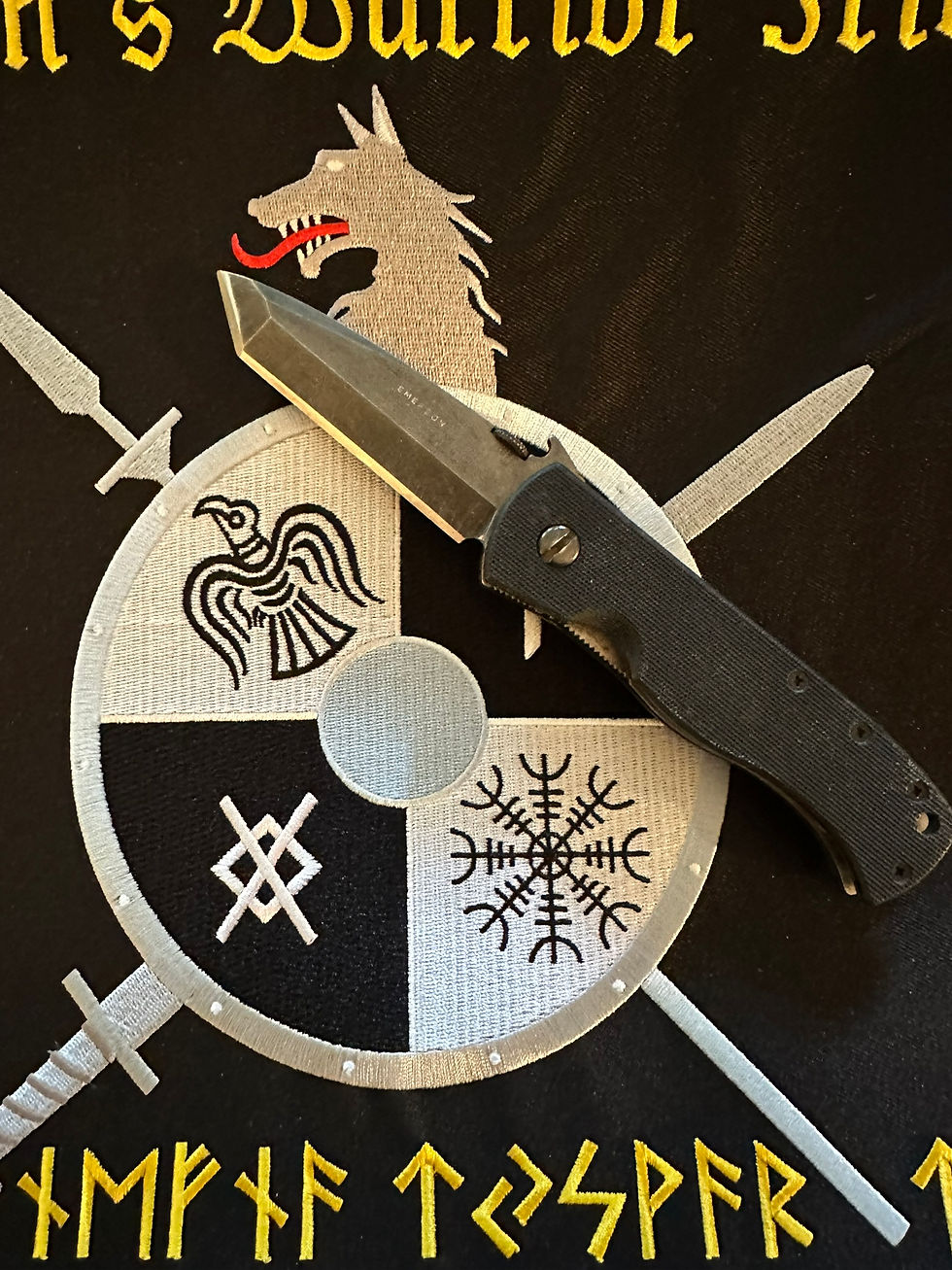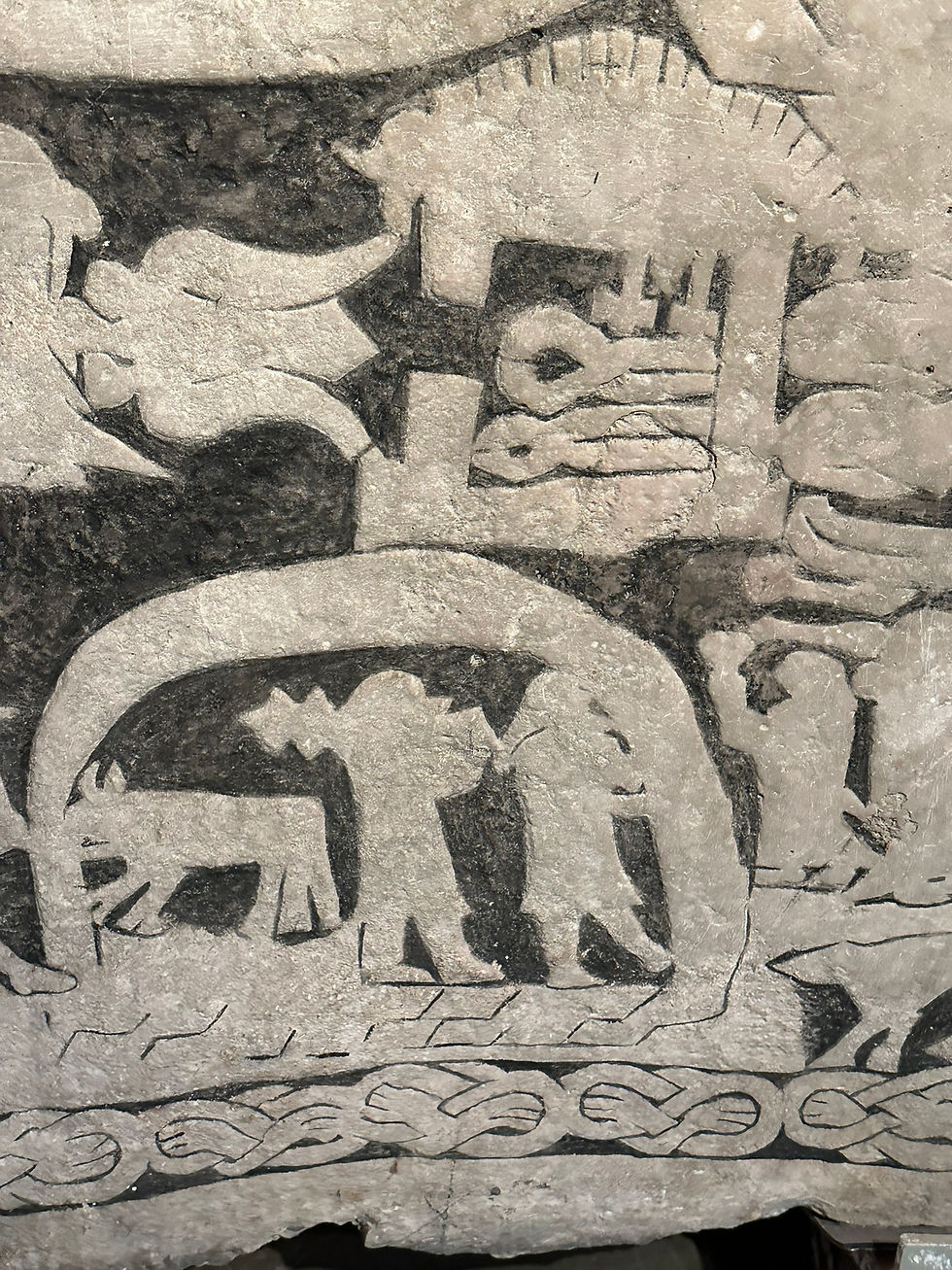KNIVES, WHETSTONES, A REVIEW OF THE "WORKSHARP PROFESSIONAL PRECISION ADJUST", AND THE CARE OF A WARRIOR’S BLADE
- Hrolfr
- Aug 9
- 5 min read
Much like many Tribe members wear their EDC knives – more on that in a bit, accounts in the Icelandic Sagas indicate that the personal knife was a constant companion, carried habitually from morning until night. Yet, it was also a tool. The prevailing method of carrying appears to have been in a sheath suspended from the belt, though the sagas also reveal alternative practices. In Gísla saga, the belt knife even serves as a final gift of last resort when all else has been given away. In the tribe we often gift knives to each other however we have a unique custom which many may be familiar with and that is that we always give a coin when we give to knife and symbolically that is tied to not cutting the friendship. In Gísla Saga, Gisli as an outlaw, presents his knife and belt to someone for saving his life and concealing him, after he had already rewarded others who had helped him by gifting his remaining valuables (from Hurstwic).

Our friends at Hurstwic Viking Combat have further researched Viking age knife carry, and found the Sagas also mention other forms of knife carry. Eyrbyggja saga notes that in the saga age, knives were often worn suspended from the neck. This is echoed in Finnboga saga, where Finnbogi employs his neck-hung knife to kill an opponent after bringing him down in a grapple. Whether at the belt or the neck, the knife was as much a symbol of preparedness as it was a functional edge. Here is a connection to the Icelandic art of wrestling (Glima) here and that points are scored when an opponent it's thrown taken down and the person who threw them is not on the ground with them. The historical meaning would be the opponent is down, they are free, free to draw their knife and to finish them off.

In ancient times and for the modern warrior, maintaining one’s blade has always been part of a deeper ethic. Those who have served in the military, in any nation, will know the maxim: “Take care of your gear, and your gear will take care of you.” This quiet discipline distinguishes the true warrior from the pretender. In the Viking Age, such care centered around the whetstone, an essential piece of kit found so often in burials that it appears to have carried both practical and symbolic weight.
One striking archaeological example comes from the Klastad ship, whose remains are housed at the Vestfold–Slottsfjell Museum in Tønsberg, Norway. Discovered in 1893 and excavated in 1970, this 20.5-meter cargo vessel was not a burial, yet its cargo included numerous whetstones—prized items in Norse times and even mentioned in the sagas. Analysis traced these stones to the Telemark region, specifically the Eidsberg quarry, which produced high-quality stone sharpening from the ninth century until its closure in 1948. Remarkably, even after the quarry shut down, Norwegian fishermen continued to use these stones to sharpen knives and whalers used them to hone harpoons and lances—until their stocks finally wore away.

The value placed on whetstones in Norse tradition is further reinforced in the Prose Edda. In one tale, Odin encounters nine thralls mowing hay and offers to whet their scythes with a stone from his belt. The improvement is so dramatic that they all wish to buy it. Odin tosses the whetstone into the air, and in their scramble to seize it, the thralls strike each other down with their own blades. The scene underscores both the worth of a fine stone and the danger inherent in edged tools.

The Chieftain trained years ago with Bruce Siddle, a well-known marital artist, law enforcement and special operations instructor. He still teaches, but at one time he taught Delta, Secret Service, Government Agencies, FBI HRU, and British units. His Edged Weapon Control System (formerly the Spontaneous Knife Defense Program) is built for imminent lethal-force knife encounters, focusing on gross-motor responses within the limits of human performance under stress. Siddle’s techniques stressed slashing and cutting, and then stabbing (only when good opportunity is presented). Its Incapacitation Template follows four steps: Check, Distract & Disrupt, Assess, and Incapacitate. More recent knife fighting systems also use combinations of cutting and slashing to create opportunity for lethal stabs. The Fairbairn–Sykes method = tied to the famous dagger - was rooted in stab-focused combat—lethal, precise, and designed to neutralize quickly. Slashing was tactical, to initiate or destabilize before a stab. Later they developed the Smatchet a short, heavy fighting knife, conceived by Fairbairn during World War II for tough, close-quarters combat.
From such stories to modern practice, the principle remains unchanged: a blade’s effectiveness depends on its edge, and its edge depends on proper maintenance. My own modern parallel is the Benchmade Emerson CQC-7, a single-bevel folding knife. This is an old school knife but one that is dependable a design that has been around since 1999. I have had two of them and they accompanied me through three of the five wars I served in. I know the feel and how to open it regardless. Recently, I restored mine using the WorkSharp Professional Precision Adjust—a modern sharpening system worthy of the warrior’s tradition. The WorkSharp professional sharpening tool was the Yule gift and not a cheap one so does the price justify the results?

Setup was straightforward: a sturdy metal frame with a continuous angle adjustment (15°–30°), a digital inclinometer for exact settings, and a stable base for bench work. The clamp holds the blade securely, while a clamp stabilizing platform improves steadiness on larger knives. I set my CQC-7 at 30°, and the system’s seven diamond abrasives (220, 320, 400, 600, 800 grit) allowed me to progress methodically, followed by a ceramic rod and leather strop for a mirror finish. No oil is needed—or even advised. The result: a flawless edge, free of burrs, slicing paper as easily as silk.

The kit also includes a small-knife table for pen blades down to 15°, making it versatile for everyday carry and kitchen use, though it is not intended for swords or very large blades. My CQC-7, scarred and worn from years of use—scraping, prying, and enduring—was restored to razor-sharp, mission-ready condition in a single session. Though it took longer since this was my first time with the setup.
Kit contents:
Metal sharpening frame with 15°–30° continuous angle adjustment
Digital angle indicator (inclinometer)
Stable benchtop base
Seven 1” × 6” diamond abrasives: 220, 320, 400, 600, 800 grit
Ceramic rod for serrations
Fine ceramic abrasive and leather strop
Metal V-block clamp
Clamp stabilizing platform
Small knife table attachment
Pricing:
MSRP: $299.95 USD
Common retail: $299.95 USD
Typical sale: ~$249.95 USD (about 17% off)
Lowest reported: $195–$225 USD, depending on retailer and timing

Verdict: Recommended for EDC enthusiasts, professional users, and anyone who understands—as the Vikings did—that the knife is both a tool and a companion, and that a well-kept edge is a reflection of the one who wields it. We often spend too much money on the item and not taking care of it. One of the tribes’ values is Be Prepared. That phrase coin by Lord Baden-Powell founder of the Scouts, is also found in the wisdom of Odin and the Havamal. The advantage of using this tool which is placed on a bench or solid platform is the ability to precisely dial in a blade angle.
“From a ship expect speed, from a shield, cover,
Keenness from a sword.”
Havamal




Comments